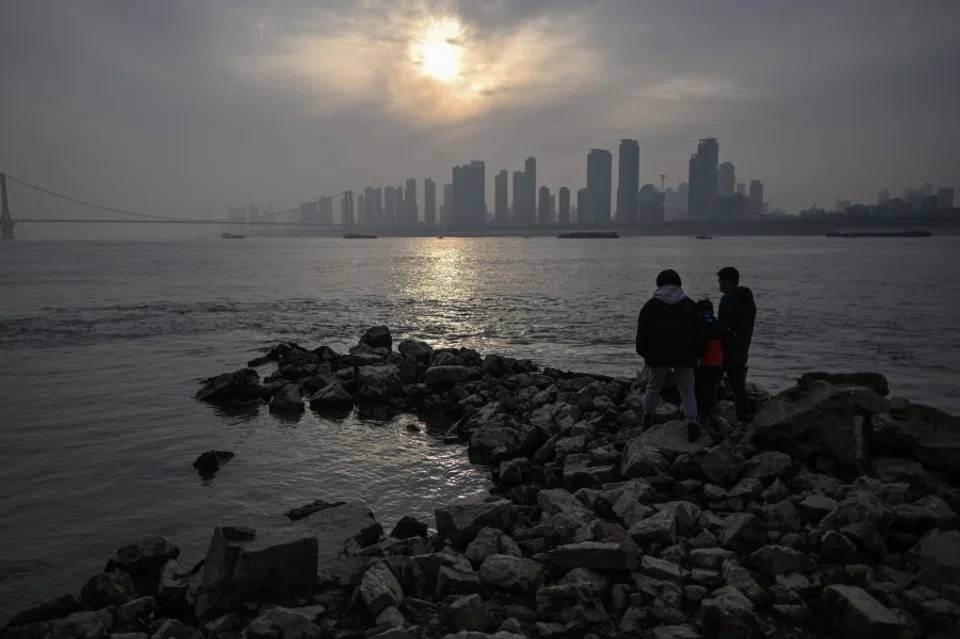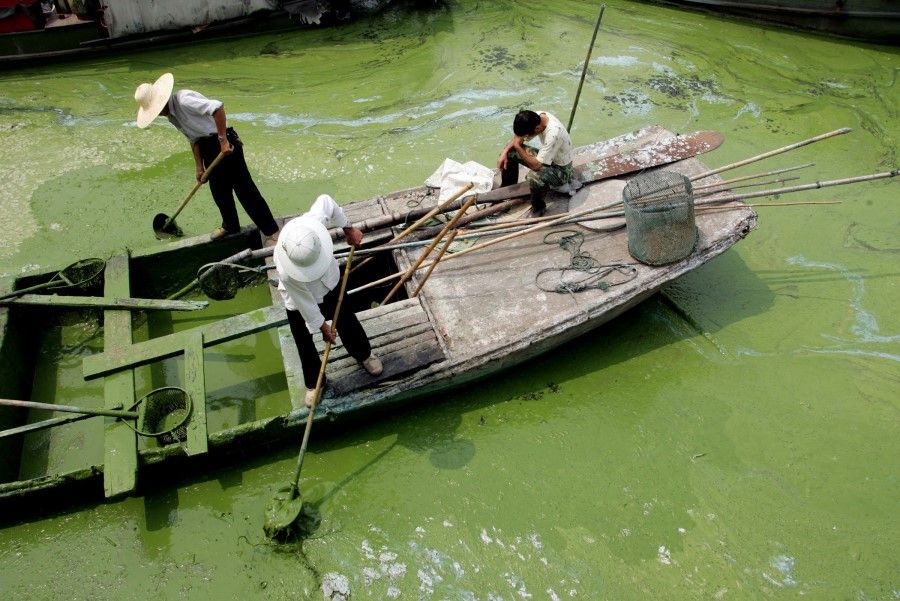China's serious water woes

Water is the source of life; survival is impossible without it, and it is an irreplaceable key resource.
China is a dry country with a severe lack of water. According to a Ministry of Water Resources of the People's Republic of China report, freshwater resources in China add up to 2.8 trillion cubic metres, which is 6% of the global total. It ranks sixth in the world, after Brazil, Russia, Canada, the US and Indonesia. However, China's per capita water resources are only 2,100 cubic metres, 28% of the world average. A study by the World Bank found that China is one of the 13 countries with the least per capita water resources, ranked 121st in the world. However, China is also a country that uses a lot of water. The volume of water used for generating every 10,000 RMB in industrial value added is 38.4 cubic metres in 2019, nearly double that of developed countries. According to a report by the Future Directions International (FDI) research institute, industrial water reuse is less than 55% across China, compared to about 75-85% in developed countries.
According to accepted international standards, if per capita water resources fall below 3,000 cubic metres, that is classified as mild water stress; below 2,000 cubic metres is moderate, below 1,000 is severe, and below 500 is extreme.
Currently, 16 provinces and cities face serious water scarcity, with six provinces (Ningxia, Hebei, Shandong, Henan, Shanxi, and Jiangsu) having less than 500 cubic metres of water per capita. Beijing - with a population of over 20 million - faces extreme water scarcity. It is one of the 111 most water-scarce cities in China, with per capita water resources at less than 300 cubic metres. This is 1/30 of global per capita water resources and 1/8 the national per capita water resources, and far less than the international alarm level of 1,000 cubic metres per head, according to a report by the Institute of Agricultural Information and Economics, Beijing Academy of Agriculture and Forestry Sciences.
As of 2019, the water levels in that region have continued to fall. This is not sustainable...
Bailing water from south to north
Besides, China's water resources are not evenly distributed between regions. According to an Asian Development Bank (ADB) report, the Yangtze River and the area to its south account for some 36% of China's total land area, but hold 81% of water resources, while the area to the north accounts for 64% of land area but only 19% of water resources.
And because the surface water has run dry, the northern region is fighting to get water from underground with super-deep wells. As of 2011, over 70,000 square kilometres of funnel-shaped depressions have been identified in the plains of northern China. Some cities have seen underground water levels drop by a total of 30 to 50 metres, while some municipalities have experienced a drop of over 100 metres, becoming the world's largest "funnel" area to underground water. As of 2019, the water levels in that region have continued to fall. This is not sustainable, which is also the fundamental reason why China has to quickly embark on its project to transfer water from the south to the north, to alleviate the severe water scarcity in the north.

Given China's immoderate use of water, some 28,000 rivers have disappeared since the 1980s. Crescent Lake at the Mogao caves in Dunhuang - a world heritage site - is drying up. At one point, it was only 0.7 metres deep, when it used to be immeasurably deep. Many coastal areas are facing the threat of seawater intrusion, while Lop Nur in Xinjiang used to be the second largest lake in China, but now it is lifeless dry sand. Such tragedies cannot be allowed to recur.
To ensure that there is enough water in the north to support economic and social development, since December 2017, Shanxi, Inner Mongolia, Shandong, Henan, Sichuan, Shaanxi, Ningxia, Beijing, and Tianjin have started levying water taxes, to curb unnecessary water usage without affecting basic usage needs. Taxes on residents and general industry remain unchanged, and the cost of normal water usage will not go up. Reasonable water usage for agriculture and production will be tax-free, while any excess usage will be taxed, but at a low rate. However, regions where groundwater is over-exploited and usage in excess of the quota will be taxed at a higher rate, and water-intensive enterprises in these areas will see a significant increase in their bill.
Yellow River in peril
The main river in northern China is the Yellow River, the figurative mother of the Chinese people. Historically, the Yellow River has made significant contributions to the flourishing and development of Chinese culture. But as the Yellow River passes through China's highlands, over many years, a lot of mud and sand has been washed along with its waters, leading to a rising riverbed and the Yellow River being known as a "hanging river overhead", a "hanging river" being one whose riverbed is higher than the surrounding floodplain. Indeed, the Yellow River has overflowed its banks and changed its course, with disastrous consequences.
And while the Yellow River is 5,464 kilometres long and is the sixth longest river in the world, its water volume is very low, with an annual flow of just 60 billion cubic metres, or 1/16 that of the Yangtze River. In the second half of the 20th century, the farmers along the middle course of the Yellow River had no idea of saving water. Irrigating fields usually meant using a lot of water, leading to a serious lack of water downstream. Between 1972 and 1999, the Yellow River dried up several times, including 226 days in 1997, and reaching as far as Kaifeng, 704 kilometres away from the sea. Only after the Yellow River Conservancy Commission came in to tackle the issue did the river start flowing again.
In order to reasonably develop, use, control, and conserve water resources, prevent disasters, maintain sustainability, and adapt to economic and social development, the National People's Congress (NPC) Standing Committee passed and implemented the Water Law in 2002, which very few countries have.
Water is scarce to begin with, and surface water is limited. Amid China's rapid economic development, for a period it overlooked environmental protection, leading to the deteriorating quality of river water and exacerbating the shortage of water resources.
Lake Tai (太湖), Lake Chao (巢湖), and Lake Dian (滇池) were rated below Grade V. As for the Yellow River, as a key water source for the north, 38.7% of it had basically lost its function.
South of China - abundant but polluted water
China's water quality is classified into five grades - Grades I-III are drinkable after processing, but not Grade IV and below, and Grade V cannot even be used for irrigation. Data from the Ministry of Environmental Protection (now the Ministry of Ecology and Environment) released in the early 2000s showed that of 412 test samples from seven major water systems, 41.8% fell under Grades I-III, 30.3% Grades IV-V, and 27.9% below Grade V.

The Haihe River was heavily polluted, while the Liao River, Huai River, Yellow River, and Songhua River were moderately polluted. The Yangtze River was mildly polluted, and only the Pearl River had good quality water. Of 27 lake reservoirs, only two were rated Grade II, five Grade III, four Grade IV, and six Grade V, while the remaining ten were below Grade V. Lake Tai (太湖), Lake Chao (巢湖), and Lake Dian (滇池) were rated below Grade V. As for the Yellow River, as a key water source for the north, 38.7% of it had basically lost its function.
In fact, the situation in China is that in the north there are rivers but they are dry, while in the south there is water but it is polluted. On the one hand, there are shouts of thirst, while on the other hand, there is water that cannot be used. Clearly, this cannot go on.
Laws to save China's rivers
And so, in 2008, the NPC Standing Committee passed the Water Pollution Prevention and Control Law, to effectively protect surface water from pollution. Also, the "river chief" system was launched, with party chiefs taking on the role of "river chiefs", to manage and protect the water quality of rivers and lakes.
Shanghai resolved to fix Suzhou Creek, but after three stages spanning 15 years and costing 14 billion RMB, the water is still not at Grade V standards. The fourth stage that began in 2019 is costing as much as 25.4 billion RMB.
Since early 2016, Chinese Communist Party General Secretary Xi Jinping spoke at Chongqing, Wuhan, and Nanjing calling for provinces and cities along the Yangtze River to protect the river and ban major development projects. At the end of last year, the NPC Standing Committee passed the Yangtze River Protection Law, and early this year, fishing was banned in major water bodies along the Yangtze River. After a lot of tough effort, the water quality in the Yangtze River has improved significantly.
Take Suzhou Creek for example, which passes Shanghai city. In the early 20th century, the water quality of the 125-kilometre Suzhou Creek was relatively good. But subsequently, as refugees from other provinces came swarming in, they pitched tents and lived beside Suzhou Creek. Later, textile factories, dyeing factories, and flour mills were set up along the river, and unprocessed wastewater was released directly into the river, quickly turning the water black and smelly. In the 1990s, it was impossible to stand beside the river for more than five minutes. Shanghai resolved to fix Suzhou Creek, but after three stages spanning 15 years and costing 14 billion RMB, the water is still not at Grade V standards. The fourth stage that began in 2019 is costing as much as 25.4 billion RMB.
Comparing lakes
No discussion of water resources would be complete without mentioning an example of a clear contrast with China's severe water shortage - Lake Baikal, located in Siberia in Russia, north of China. Its total volume is 23.6 trillion cubic metres, with an average depth of 730 metres. Its deepest point is 1,637 metres, making it the world's deepest lake and the largest freshwater lake in Eurasia. The lake is 636 kilometres long with an average width of 48 kilometres, and an area of 31,500 square kilometres. China's old name for Lake Baikal was the Northern Sea, and it was the main area of activity for the northern tribes of China. For a short while, it was under the control of the Qing dynasty, but the area was returned to Russia following the Treaty of Nerchinsk. The area was where the Han dynasty diplomat Su Wu was exiled to tend sheep, some 2,000 years ago.
China's five major lakes have an area of less than a third of Lake Baikal, which gives a picture of China's severe water shortage.

There are 336 rivers that flow into Lake Baikal, including the Selenga. It has a catchment area of 557,000 square kilometres, and only one river flowing out of it, the Angara. It contains one-fifth of the world's freshwater. The five Great Lakes of North America put together are 7.8 times the area of Lake Baikal, but their volume is slightly less, showing the amazing amount of water in Baikal. All the water bodies in China hold a total of 2.8 trillion cubic metres of water, just 11.8% the volume of Lake Baikal.
Even more unimaginable, not only does Lake Baikal hold by far the most water in the world, that water is also among the clearest, with visibility up to a depth of 40 metres, which makes it the cleanest lake in the world today, with water that can almost be drunk directly. In comparison, China's saltwater lakes are also quite deep, such as Qinghai Lake in western China (even then at 18.6 metres deep, it is definitely much shallower than Lake Baikal), while the depth of freshwater lakes is not worth mentioning - Poyang Lake is the deepest of China's five major lakes, with an average depth of just 16 metres, while Lake Chao has an average depth of 1.9 metres. And China's five major lakes have an area of less than a third of Lake Baikal, which gives a picture of China's severe water shortage. At the same time, one cannot help regretting that the inept Qing government ceded those 1.5 million square kilometres of land, including Lake Baikal, to the Russian Empire.
Water an irreplaceable resource
Oil has always been seen as the lifeblood of industries, and its importance to economic and social development goes without saying. Even so, countries with rich oil resources are rare, and most countries can only depend on oil imports. China is the world's number one oil importer today. Oil can be imported, crucial as it is, but for a large, populous country like China to import water to maintain its growth would be unimaginable. It would not be much of a problem to bring in water to a country like Singapore with its small population, or a city like Hong Kong. But Singapore and Malaysia have not stopped arguing over importing fresh water.
Besides, in order to handle climate change, various countries are announcing timelines to end the sale of petrol vehicles, and China is also studying when is a good time to do so. Furthermore, as alternatives to fossil fuels, hydroelectric power, nuclear power, wind power, and solar power are now also showing their worth, which means that in the foreseeable future, oil might become significantly less important.
However, water is irreplaceable. And so, in the process of economic and social development, it is a priority to come up with a necessary strategy for water resources, to ensure reasonable use while instilling the idea of conserving water in each person to ensure China's water security, while ensuring sustainable economic and social development. Otherwise, the last drop of moisture one sees may well be one's own tears, and this is not scaremongering.
